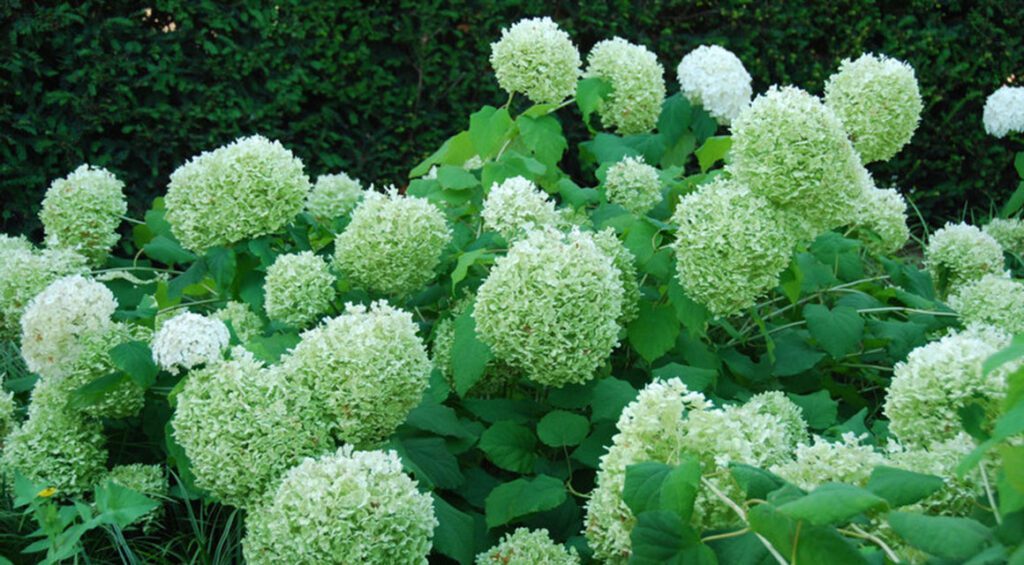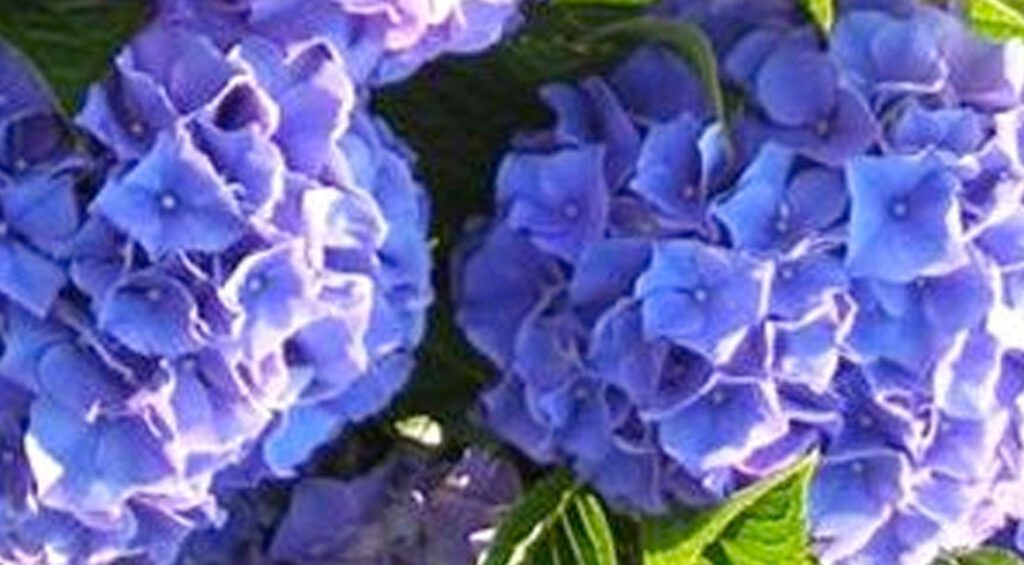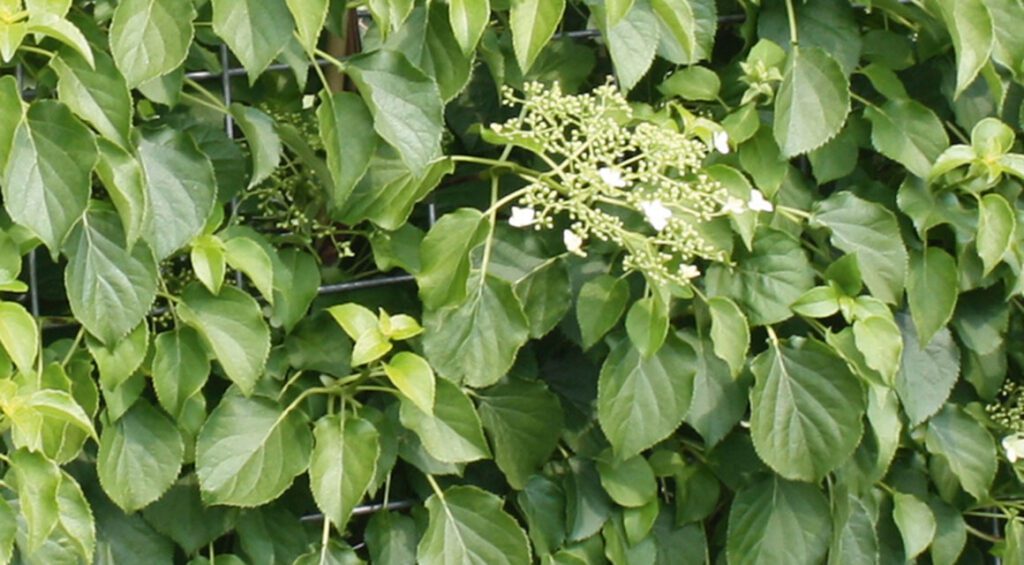Many know hydrangeas mainly as beautiful and stylish flowers. But did you know that hydrangeas can be used as hedge plants? A hydrangea hedge will give your garden a rural and at the same time carefree character. Hydrangeas are also suitable for being planted in groups. Would you like to plant a beautiful hydrangea hedge in your garden? Then we’ll be happy to help you with everything you need to know. We will tell you what to look for when planting the hedge and which hydrangeas are best suited for it.

Contents
What hydrangeas are suitable for a hedge?
Hydrangeas (Hydrangea) shed their foliage in winter. If you are looking for a hedge that will provide some privacy, it is better to choose an evergreen hedge plant with a compact growth habit. With hydrangeas, you will create a beautiful and stylish setting for your garden. In addition, the hedge offers an exceptionally beautiful sea of flowers in spring and autumn. There are several hydrangeas that are suitable for low, informal hedges. We have already selected the best hydrangeas for you. All you have to do is choose your favorite hydrangea in our web store.
Hydrangea ‘Bodensee’ (Hydrangea macrophylla ‘Bodensee’) is a variety that is particularly suitable as a hedge plant. From July to September, this hydrangea blooms with spherical inflorescences in a beautiful blue to light purple color. Hydrangea ‘Bodensee’ blooms on two-year-old wood. In this it differs from other hydrangea varieties. Shorten the branches by about half when you prune. This way you can enjoy the beautiful flowers that Hydrangea ‘Bodensee’ adorns itself with every summer. Did you know that the color of hydrangea ‘Bodensee’ is determined by the type of soil in which it is planted?

Hydrangea ‘Bodensee’ reacts to acid soil in a special way: It gets a different color. Depending on the soil, the color of Hydrangea ‘Bodensee’ varies from pink to purple to blue. On acidic soils, this hydrangea tends to get blue flowers, while on calcareous soils it blooms pink to dark pink. To get the coveted blue-purple color, many garden owners enrich the soil of Hydrangea ‘Bodensee’ with iron fertilizer. You too can influence the flower color of your rhododendron in this way!
Hydrangea ‘Alpenglühen’ (Hydrangea macrophylla ‘Alpenglühen’) is also commonly used for hedges. Neither hedge plant requires much maintenance and both develop into attractive, low hedges. We often see these hydrangeas in country gardens, but they are also frequently included in formal garden styles. In formal gardens, they like to be planted in groups or as specimen plants, but not as hedge plants. Hydrangea ‘Alpenglühen’ bears dark pink to red flowers that are characterized by a rounded inflorescence. Like Hydrangea ‘Bodensee’, it blooms from July to September. These hydrangeas can therefore be planted together if you want all the plants in your hedge to bloom at the same time.

Other hydrangeas suitable as a hedge plant.
With the above varieties of hydrangea, you can create a beautiful, rural hedge. In our webshop you will find many more hydrangeas that you can use for a hedge. A completely different type of hedge plant is the climbing hydrangea. As the name suggests, this is a climbing plant that grows best up a garden wall or facade. Climbing hydrangea is a deciduous plant, which is characterized by its rapid growth. In July and August, this climber blooms with beautiful white umbrella panicles. Climbing hydrangeas are also just right in a bird-friendly garden, because animals will happily nest among the branches of this hedge plant if it has grown tall enough.
Another hydrangea that is popular as a hedge plant is the ball hydrangea ‘Annabelle’ (Hydrangea arborescens ‘Annabelle’). The round inflorescences that form on the branches of hydrangeas from July to September are pale green to white. This hedge plant is suitable for low, informal hedges. In our assortment you will also find the panicle hydrangea ‘Kyushu’ (Hydrangea paniculata ‘Kyushu’), the panicle hydrangea ‘Vanille Fraise’ (Hydrangea paniculata ‘Vanille Fraise’) and the oakleaf hydrangea. Take a look around our web store and decide which hydrangea best suits your garden design.

How many hydrangeas per meter?
To create a beautiful hydrangea hedge, you need about two to three hydrangeas per meter. If you buy smaller varieties like the oakleaf hydrangea, you may need a bit more specimens. Hydrangeas are easy to care for once planted. Some species require almost no pruning at all, which is an advantage if you don’t want to spend a lot of time in the garden. Fertilize hydrangeas with organic fertilizer to ensure the shrub stays healthy and vigorous. A healthy hydrangea in good condition will grow well and bloom profusely.
With proper care, a hydrangea shrub will remain full and vigorous. Especially because hydrangeas never grow completely opaque as a hedge, it is important to keep them as compact and full as possible. You can achieve this by pruning the hedge plant from time to time to allow new branching to form. Pruning also stimulates flowering, which can be very abundant, especially with hydrangeas.

